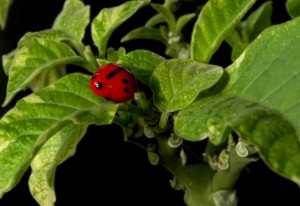 The weather outside is frightful (well, some days it is) and your have some garden plants that you want to bring inside to keep growing strong. The big problem we find is with the bugs that come in with those outside plants, now houseplants.
The weather outside is frightful (well, some days it is) and your have some garden plants that you want to bring inside to keep growing strong. The big problem we find is with the bugs that come in with those outside plants, now houseplants.
You can use various house pesticides to kill off bugs on the plants, but depending on how much pesticide you need, or use, it can create an unhealthy buildup of chemicals around the house.
So How Does One Treating Houseplants for Bugs?
From the Associate Press & ABC News
I try to avoid using pesticides altogether. They are just one approach to controlling pests, and should be the last one. Other approaches may demand greater intimacy with your pests, learning their habits and life cycles, but that’s part of what makes gardening interesting. Books such as “The Gardener’s Guide to Common-Sense Pest Control” by William and Helga Olkowski, and “The Organic Gardener’s Handbook of Natural Pest and Disease Control” edited by Fern Marshall Bradley, Barbara W. Ellis and Deborah Martin, detail ways to control many houseplant pests.
For now, I’m dealing with scale insects by flicking any that I see off leaves with my thumbnail. I know I won’t eliminate them with this brute-force method, but I can at least keep the population in check. In a couple of months, they might get ahead of me, but by then perhaps the ladybugs that call my home their home will help out, as they have in years past.
I’ve used similar methods against aphids, crushing them where they congregate on leaves near the tips of stems, and against mealybugs, doing them in with a cotton swab dipped in alcohol. Keeping an aphid-infested plant in the shower will wash the pests away and create conditions inimical to another common pest, red spider mites, which are hard to see but make their presence known by imparting a bronze cast to leaves.
Trapping is a more elegant approach to pest control. Thwart aphids on single- or few-stemmed plants by blocking travel of the ants that herd and protect them: Wrap a sticky band around the stem or stems. Masking tape coated with sticky Tangle-Trap works and lasts for weeks. If clouds of whiteflies puff up whenever you brush against your geraniums, place yellow cards coated with oil or Tangle-Trap near the plants.
Good growing conditions also can help deter pests. Less frequent watering, for instance, is usually all that’s needed to deal with fungus gnats or sowbugs.
Yes, the occasional pest-ridden houseplant will need the last resort, a pesticide spray (or a walk to the compost pile, always an option). Even then, there are some effective and relatively nontoxic sprays, such as insecticidal soap, horticultural oil and Bt. By the time a spray is needed, the weather likely will have warmed enough that it can be done outdoors. Hold pests at bay long enough and you can move houseplants outdoors for their summer vacation, where pest problems frequently clear up by themselves.